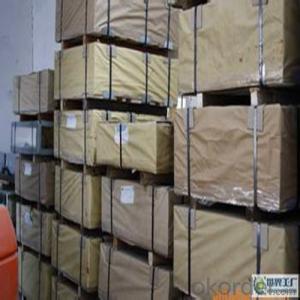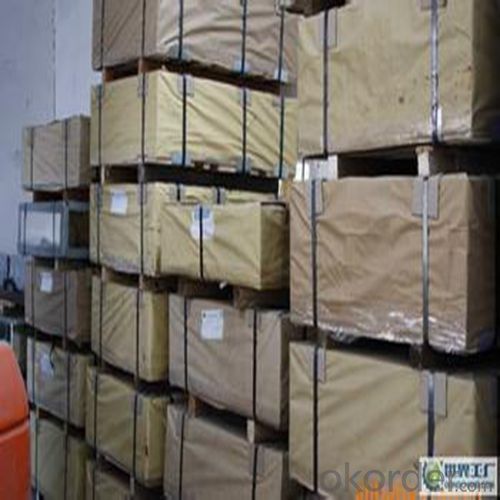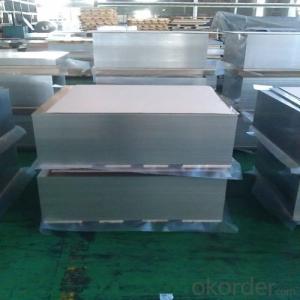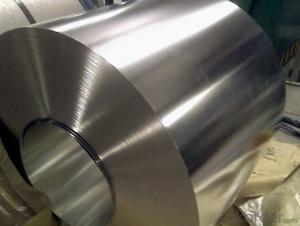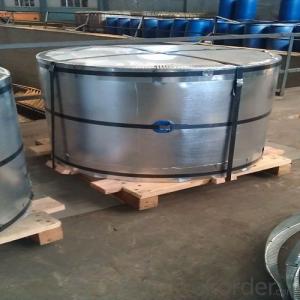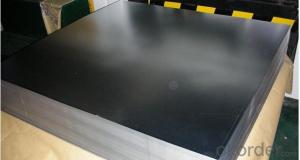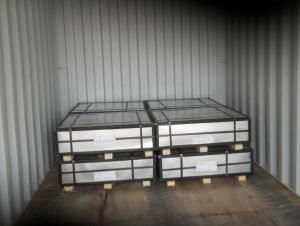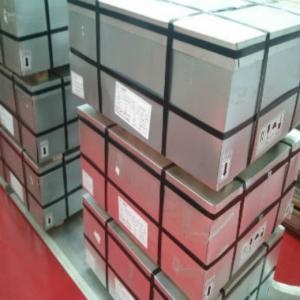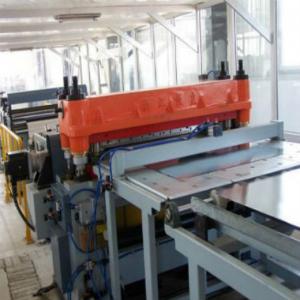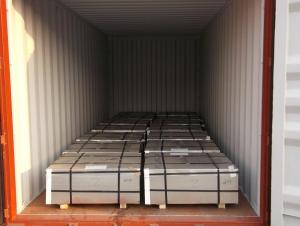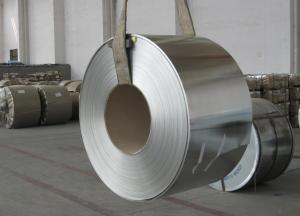Electrolytic Tinplate ETP for Metal Containers 0.22 T4 CA
- Loading Port:
- Tianjin
- Payment Terms:
- TT OR LC
- Min Order Qty:
- 25 m.t.
- Supply Capability:
- 10000 m.t./month
OKorder Service Pledge
OKorder Financial Service
You Might Also Like
1.Structure of Electrolytic Tinplate ETP for Metal Containers 0.22 T4 CA Description
Electrolytic Tinplate, is one thin steel sheet with a coating of tin applied by electrolytic deposition. Tinplate made by this process is essentially a sandwich in which the central core is strip steel. This core is cleaned in a pickling solution and then fed through tanks containing electrolyte, where tin is deposited on both sides. As the strip passes between high-frequency electric induction coils, it is heated so that the tin coating melts and flows to form a lustrous coat.
2.Main Features of the Electrolytic Tinplate ETP for Metal Containers 0.22 T4 CA
Appearance – Tinplate is characterized by its beautiful metallic luster. Products with various kinds of surface roughness are produced by selecting the surface finish of the substrate steel sheet.
Paintability and printability – Tinplates have excellent paintability and printability. Printing is beautifully finished using various lacquers and inks.
Formability and strength – Tinplates have got very good formability and strength. By selecting a proper temper grade, appropriate formability is obtained for different applications as well as the required strength after forming.
Corrosion resistance – Tinplate has got good corrosion resistance. By selecting a proper coating weight, appropriate corrosion resistance is obtained against container contents. Coated items should meet 24 hour 5 % salt spray requirement.
Solderability and weldability – Tinplates can be joined both by soldering or welding. These properties of tinplate are used for making various types of cans.
Hygienic – Tin coating provides good and non toxic barrier properties to protect food products from impurities, bacteria, moisture, light and odours.
Safe – Tinplate being low weight and high strength makes food cans easy to ship and transport.
Eco friendly – Tinplate offers 100 % recyclability.
Tin is not good for low temperature applications since it changes structure and loses adhesion when exposed to temperatures below – 40 deg C.
3.Electrolytic Tinplate ETP for Metal Containers 0.22 T4 CA Images
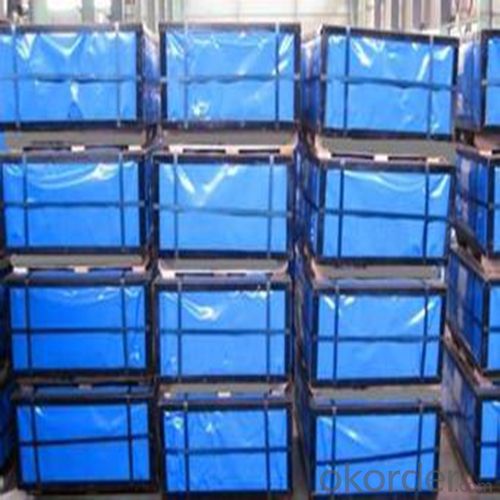


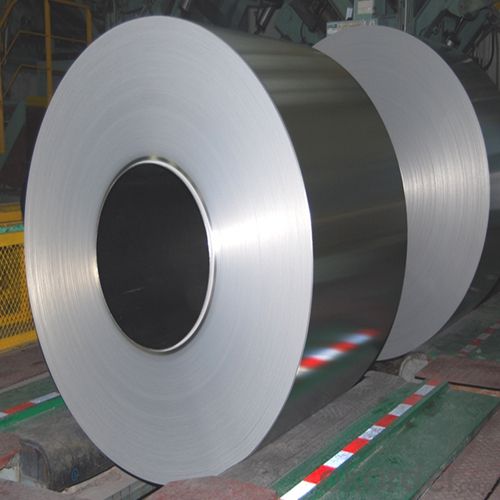
4.Electrolytic Tinplate ETP for Metal Containers 0.22 T4 CA Specification
Standard: ISO 11949 -1995
Material: MR
Thickness:0.22mm
Width: 600mm -1150mm
Temper: T4
Annealing: CA
Coil Inner Diameter: 508mm
Weight: 6-10 tons/coil 1~1.7 tons/sheets bundle
Passivation:311
Oil: DOS
Surface: Finish
5.FAQ of Electrolytic Tinplate ETP for Metal Containers 0.22 T4 CA
- How are the tinplates specified?
The tinplates are specified as per the steel base, extent of tempering, the coating weight, annealing method and the surface finish.
- How many types there are for base steels?
The base steels are of three types: Type MR, L, D
- Q: How does tinplate affect the overall product freshness?
- Tinplate, due to its excellent barrier properties, helps to preserve the freshness and quality of products. It prevents oxygen and moisture from entering the packaging, thereby reducing the risk of spoilage, deterioration, or contamination. This ensures that the product remains fresh and maintains its desired characteristics for an extended period.
- Q: What are the common defects found in tinplate packaging?
- Common defects found in tinplate packaging include: 1. Corrosion: Tinplate can be prone to corrosion, resulting in rust spots or holes in the packaging. This can compromise the integrity of the packaging and affect the quality and safety of the product inside. 2. Dents and scratches: During handling or transportation, tinplate packaging can get dented or scratched. These defects can be purely cosmetic, but in some cases, they may lead to leaks or damage to the product. 3. Poor sealing: Improper sealing of tinplate packaging can lead to leaks or contamination of the product. This can occur due to faulty machinery or inadequate quality control during the packaging process. 4. Print defects: Tinplate packaging often includes printed information or branding. Common defects in this area include misalignment, smudging, fading, or incomplete printing. These defects can affect the visual appeal of the packaging and the overall product presentation. 5. Manufacturing defects: Tinplate packaging can sometimes have manufacturing defects such as uneven edges, poor welds, or misaligned seams. These defects may weaken the packaging structure or cause sharp edges that could potentially harm consumers. It is important for manufacturers to have strict quality control measures in place to identify and rectify these defects, ensuring the safety, functionality, and aesthetics of tinplate packaging.
- Q: How does tinplate packaging contribute to product marketing?
- Tinplate packaging contributes to product marketing in several ways. Firstly, it enhances the visual appeal of the product, making it more attractive to potential customers. The shiny and vibrant nature of tinplate packaging can catch consumers' attention and create a positive first impression. Additionally, tinplate packaging can be customized with high-quality printing, allowing for brand logos, product information, and eye-catching designs to be prominently displayed. This helps build brand recognition and reinforces brand image. Moreover, tinplate packaging provides durability and protection, ensuring that the product remains in good condition during transportation and on store shelves. This reliability can instill trust in consumers and enhance the perceived value of the product. Overall, tinplate packaging plays a crucial role in differentiating products from competitors and influencing purchasing decisions through its visual appeal, branding opportunities, and protective qualities.
- Q: What industries commonly use tinplate?
- The industries that commonly use tinplate include food and beverage packaging, cosmetics, pharmaceuticals, automotive, and electronics.
- Q: How does tinplate compare to aluminum in terms of recyclability?
- Tinplate is highly recyclable, just like aluminum. Both materials can be recycled repeatedly without losing their properties or quality.
- Q: Can tinplate be used for chemical storage containers?
- Yes, tinplate can be used for chemical storage containers. Tinplate is a type of steel coated with a thin layer of tin, which provides excellent corrosion resistance. This makes it suitable for storing various chemicals as it helps to prevent chemical reactions and preserve the integrity of the container.
- Q: How does tinplate packaging contribute to product reusability?
- Tinplate packaging contributes to product reusability by providing a durable and long-lasting material that can be easily reused for various purposes. Its strong resistance to corrosion and high durability make tinplate packaging suitable for multiple uses, such as storing food, beverages, or other products. Additionally, the ability to seal and reseal tinplate packaging ensures the preservation and freshness of the contents, enabling consumers to reuse the packaging for future storage needs. This reduces waste and promotes sustainability by minimizing the need for single-use packaging materials.
- Q: What are the main challenges in tinplate labeling?
- The main challenges in tinplate labeling include ensuring the label adheres properly to the curved surface of the tinplate, maintaining label legibility and durability despite potential exposure to moisture, heat, or other harsh conditions, and avoiding label peeling or lifting due to the rigidity of the tinplate material. Additionally, achieving accurate and consistent label placement can be challenging due to the irregular shape and size variations of tinplate containers.
- Q: What are the health and safety concerns associated with tinplate?
- Some health and safety concerns associated with tinplate include potential exposure to tin, which can cause respiratory issues and skin irritation if inhaled or in contact with the skin for prolonged periods. Additionally, the coatings used on tinplate may contain harmful chemicals like bisphenol A (BPA), which has been linked to various health problems. It is important to handle and use tinplate products with caution, ensuring adequate ventilation and avoiding direct contact with the coating.
- Q: How does tinplate contribute to the shelf life of beverages?
- Tinplate contributes to the shelf life of beverages by providing a protective barrier that prevents contact between the beverage and its container. This barrier helps to prevent oxidation, contamination, and the transfer of flavors, ensuring the beverage stays fresh and retains its quality for a longer period of time. Additionally, tinplate containers are resistant to corrosion, maintaining the integrity of the packaging and further extending the shelf life of the beverages.
Send your message to us
Electrolytic Tinplate ETP for Metal Containers 0.22 T4 CA
- Loading Port:
- Tianjin
- Payment Terms:
- TT OR LC
- Min Order Qty:
- 25 m.t.
- Supply Capability:
- 10000 m.t./month
OKorder Service Pledge
OKorder Financial Service
Similar products
Hot products
Hot Searches
Related keywords
